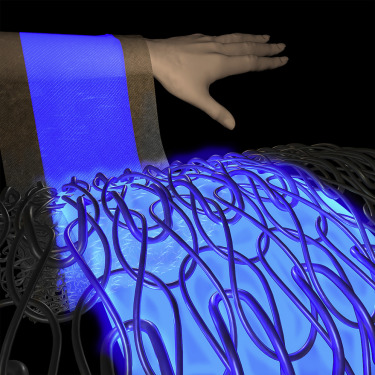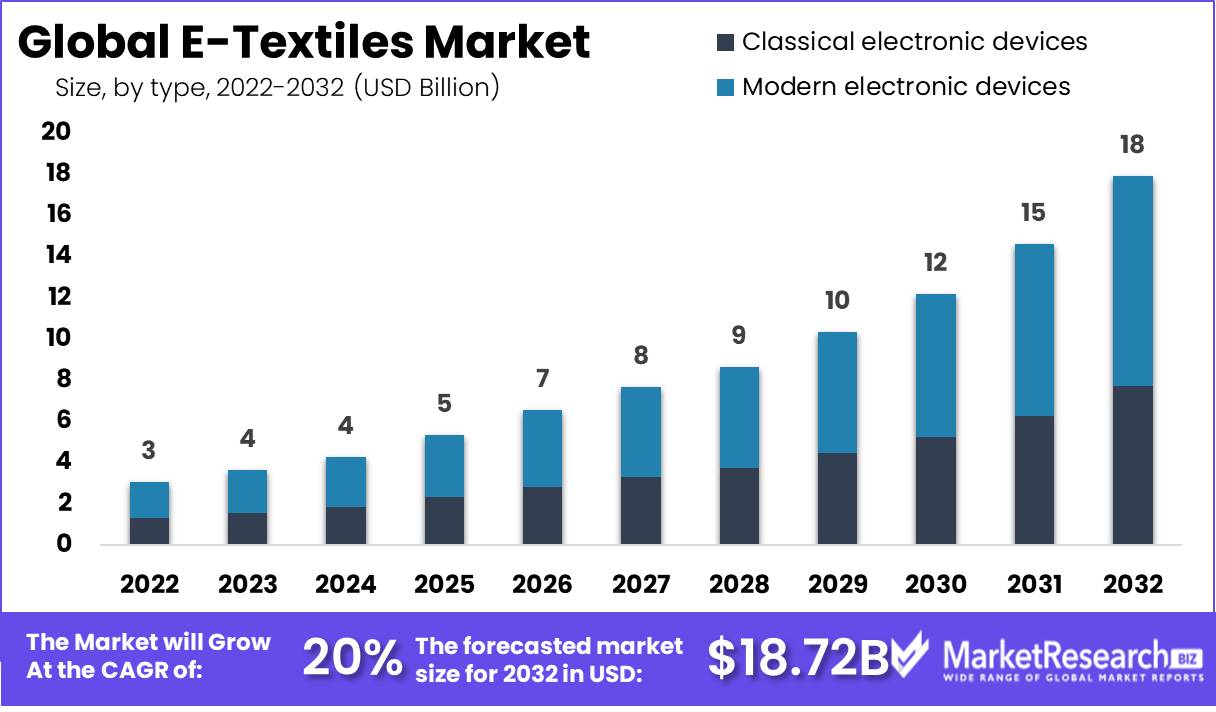E-Textiles Market Accelerating At A CAGR Of 20% During The Forecast Year

Page Contents
Market Overview
Published Via 11Press : E-Textiles Market facilitates the growth of ubiquitous technology. In the following section, we will discuss the market for e-textiles, including its evolution, innovations, and applications. In addition, we will investigate the ethical considerations and responsible use of e-textiles in commercial applications. Rising demand for wearable technology and the convergence of electronics and textiles are responsible for the market expansion.
Numerous significant developments have occurred in the E-Textiles Market. There are also intelligent textiles and stretchable electronics. Conductive fabrics are used in sensors and other electronic devices because they can conduct electricity. Intelligent textiles can modify their colour, form, and texture in response to external stimuli. Stretchable electronics are devices that can be stretched without breaking, making them suitable for incorporation into e-textiles.
E-Textiles Market is estimated to be worth roughly USD 18.72 billion by 2032, up from USD 3.02 billion in 2022, rising at a CAGR of 20% between 2023 and 2032

Key Takeaways:
- Growing demand: The e-textiles market is experiencing significant growth due to the increasing demand for wearable technology and the internet of things (IoT).
- Integration of electronics: E-textiles combine the functionality of traditional textiles with electronic components such as sensors, batteries, and LEDs, making them highly versatile and practical.
- Diverse applications: E-textiles are being used in a range of applications, including sports and fitness, medical devices, military and defense, and fashion.
- Innovation and R&D: The e-textiles market is driven by innovation and continuous research and development to enhance the capabilities and functionality of e-textiles.
- Environmental concerns: The e-textiles industry is also focused on sustainability, with an emphasis on reducing the environmental impact of production processes and materials used.
- Future outlook: The e-textiles market is expected to continue its growth trajectory, driven by the increasing demand for wearable technology and advancements in materials and technology.
Regional Snapshot
- North America: North America is the largest market for e-textiles and is expected to continue its dominance in the coming years. The region is home to several major e-textiles manufacturers and has a high rate of adoption of smart clothing among consumers. The United States is the major market in North America, with Canada following closely behind.
- Europe: Europe is the second-largest market for e-textiles and is expected to see significant growth in the coming years. The region has a high demand for wearable technology and has a strong focus on innovation. The United Kingdom, Germany, and France are the major markets in Europe, with Italy, Spain, and the Netherlands also showing significant growth potential.
- Asia-Pacific: The Asia-Pacific region is expected to see the fastest growth in the e-textiles market, owing to the increasing adoption of wearable technology and the presence of several major textile manufacturers in the region. China is the largest market in the region, followed by Japan and South Korea. India, Australia, and Singapore are also emerging markets for e-textiles.
- Rest of the World: The Rest of the World market for e-textiles includes regions such as Latin America, the Middle East, and Africa. These regions are expected to see moderate growth in the coming years, owing to the increasing adoption of wearable technology and the presence of several textile manufacturers. Brazil, South Africa, and the United Arab Emirates are the major markets in these regions.
Drivers:
- Growing demand for wearable technology: With the increasing popularity of fitness trackers, smartwatches, and other wearable devices, the demand for e-textiles that can be integrated into these products is growing rapidly.
- Advancements in textile manufacturing: Technological advancements in textile manufacturing, such as the ability to print conductive inks onto fabric, have made it easier and more cost-effective to produce e-textiles.
- Increasing use of sensors: E-textiles are often used in conjunction with sensors that can monitor a variety of physiological and environmental factors, such as heart rate, temperature, and humidity. As the use of sensors continues to grow, so will the demand for e-textiles.
- Growing interest in smart clothing: Smart clothing, which incorporates e-textiles and other smart technologies, is becoming increasingly popular in the fashion industry. This is driving demand for e-textiles that can be used to create these innovative new products.
- Medical applications: E-textiles are increasingly being used in the medical field to create wearable devices that can monitor patients' vital signs, track their movements, and more. As the demand for these types of devices grows, so will the demand for e-textiles.
Restraints:
- High cost: E-textiles often involve the integration of complex electronics with fabrics, which can make them more expensive to manufacture than traditional textiles. This high cost can limit their adoption in certain industries or applications.
- Limited durability: Textiles are typically designed to withstand wear and tear from daily use, but adding electronics to them can make them more fragile. E-textiles may not be as durable as traditional textiles, which could limit their use in applications where high durability is required.
- Technical complexity: E-textiles require a unique skill set that combines knowledge of textiles and electronics. This can make it difficult for manufacturers to find skilled workers and can limit the growth of the industry.
- Regulatory issues: The integration of electronics into textiles can raise concerns about safety and regulatory compliance. E-textiles may need to undergo additional testing and certification before they can be sold in certain markets.
- Limited availability of materials: Some of the materials used in e-textiles, such as conductive threads and fabrics, may be in limited supply. This could impact the availability and cost of e-textiles products.
Opportunities
- Sports and Fitness: E-textiles can be used in sports and fitness clothing to monitor heart rate, track movement and provide valuable data to improve training and performance.
- Medical Applications: E-textiles can be used in the medical field for monitoring vital signs, tracking medication adherence, and even providing remote patient monitoring.
- Fashion Industry: E-textiles can be used in fashion industry to create clothing with dynamic patterns, light displays, or even temperature-sensitive materials that respond to the wearer's environment.
- Military and Defense: E-textiles can be used in military and defense to create lightweight, flexible and rugged clothing that is capable of withstanding harsh environments and conditions.
- Home Automation: E-textiles can be used in home automation by incorporating smart fabrics into curtains, carpets, and other home furnishings to monitor and control the home environment.
- Automotive Industry: E-textiles can be used in the automotive industry to create intelligent car seats, seat belts and steering wheels which can detect drowsiness or provide feedback on the driver’s posture.
- Entertainment: E-textiles can be used in the entertainment industry to create interactive costumes and props for films and theatrical productions.
Challenges
- Integration and compatibility: Integrating electronic components into textiles requires a high level of expertise and innovation, as the components need to be flexible, lightweight, and able to withstand wear and tear. Additionally, there are compatibility issues that must be addressed when integrating different types of electronic components.
- Durability and washability: Textiles are often subject to frequent washing and drying, which can damage the electronic components if they are not designed and tested to withstand these conditions. Developing e-textiles that are both durable and washable is a significant challenge.
- Power and energy management: Powering electronic components in textiles requires lightweight and compact batteries or power sources that can be easily integrated into the fabric. Managing power consumption and minimizing energy usage is also essential for e-textiles to be practical and feasible.
- Safety and regulatory compliance: Electronic components used in textiles must meet strict safety and regulatory requirements to ensure that they do not pose a risk to wearers. Meeting these requirements can be challenging and costly, especially for small companies and startups.
- Cost and scalability: Developing and manufacturing e-textiles is currently more expensive than traditional textiles, which can make them less accessible to consumers. Additionally, scaling up production to meet growing demand can be challenging, as it requires significant investment and infrastructure.
Market Segmentation
Segmentation by type:
- Classical electronic devices
- Modern electronic devices
Segmentation by application:
- Medical & healthcare
- Defence
- Home & lifestyle
- Fashion
- Sports & fitness
- Industrial
- Commercial & military
- Others
Key Players
- Fibretronic Ltd.
- Accenture PLC
- Apple Inc.
- AiQ Smart Clothing Ltd.
- Adidas AG
- Clothing Plus Ltd.
- Interactive Wear AG
- Ohmatex ApS
- Fujitsu Limited
- Hoffmann-La Roche AG
Report Scope
| Report Attribute | Details |
| Market size value in 2022 | USD 3.02 billion |
| Revenue forecast by 2032 | USD 18.69 billion |
| Growth Rate | CAGR of 20% |
| Regions Covered | North America, Europe, Asia Pacific, Latin America, and Middle East & Africa, and Rest of the World |
| Historical Years | 2017-2022 |
| Base Year | 2022 |
| Estimated Year | 2023 |
| Short-Term Projection Year | 2028 |
| Long-Term Projected Year | 2032 |
Recent Development
The impressive collaboration between Google and Levi's Project Jacquard has completely revolutionised the intriguing and rapidly evolving world of e-textiles. Combining Google's extensive expertise in the field of smart fabrics with Levi's world-famous denim to create a stunning line of apparel with extraordinary features such as touch-sensitive panels integrated into jackets and backpacks is a perfect match. These touch-sensitive panels enable users to control mobile devices such as smartphones without pausing or removing their clothing. This type of technological innovation has never been seen before in the fashion industry, and it will undoubtedly revolutionise our daily lives.
DuPont, a renowned leader in the field of materials science, has developed a remarkable assortment of conductive dyes and materials that are essential for the production of e-textiles by February 2021. These materials enable the seamless integration of technology into clothing, resulting in the creation of revolutionary products that make it simpler than ever to stay connected and monitor our health and wellness.
FAQ
Q: What is the Projected CAGR value of the E-Textiles Market?
A: E-Textiles Market is expected to grow at a CAGR of 20%
Q: What are the key players in the e-textiles market?
A: Fibretronic Ltd, Accenture PLC, Apple Inc, AiQ Smart Clothing Ltd, Adidas AG, Clothing Plus Ltd, Interactive Wear AG, Ohmatex ApS, Fujitsu Limited,Hoffmann-La Roche AG
Q: Which is the fastest-growing region in the E-Textiles Market?
A: The E-textiles market scenario portrays a favourable picture for Europe, which has emerged as the global market leader.
Q: What are the key factors driving the growth of this market report?
A: • High demand for health-monitoring wearables
• Increasing adoption of BLE technology and miniaturization of electronic components
Contact us
Contact Person: Mr. Lawrence John
Marketresearch.Biz (Powered By Prudour Pvt. Ltd.)
Tel: +1 (347) 796-4335
Send Email: [email protected]
Inquiry: [email protected]
Content has been published via 11press. for more details please contact at [email protected]
The team behind market.us, marketresearch.biz, market.biz and more. Our purpose is to keep our customers ahead of the game with regard to the markets. They may fluctuate up or down, but we will help you to stay ahead of the curve in these market fluctuations. Our consistent growth and ability to deliver in-depth analyses and market insight has engaged genuine market players. They have faith in us to offer the data and information they require to make balanced and decisive marketing decisions.